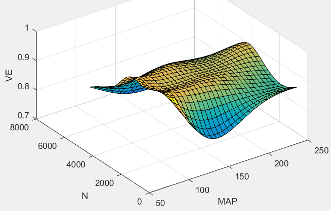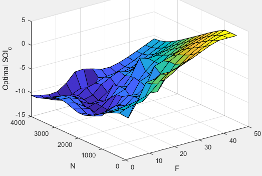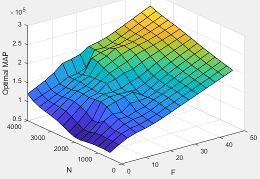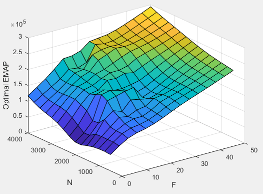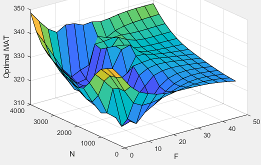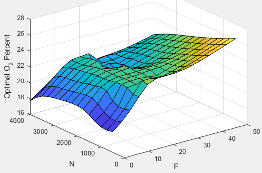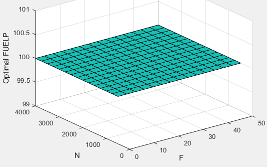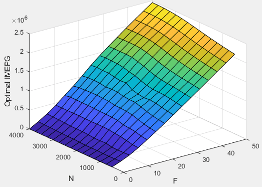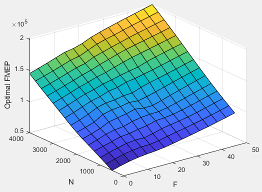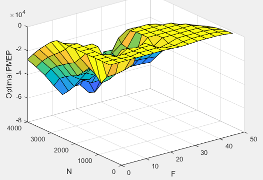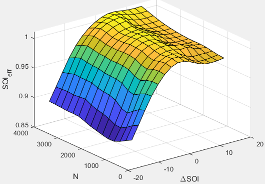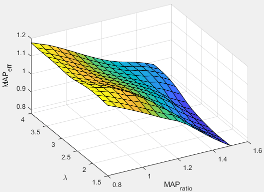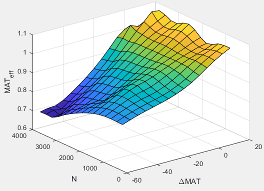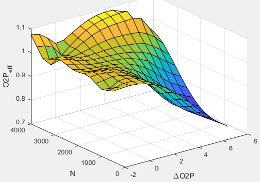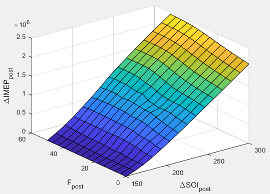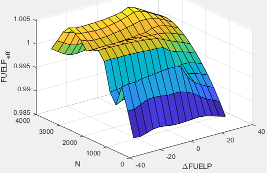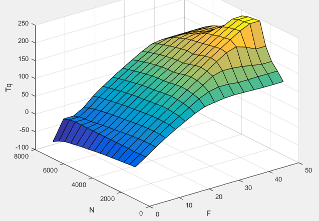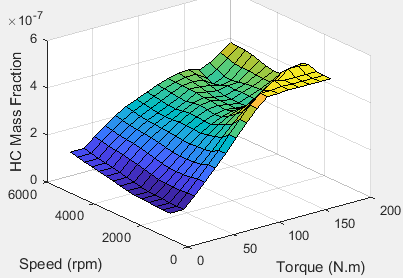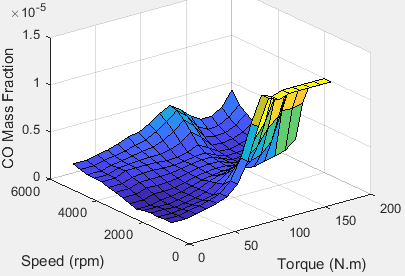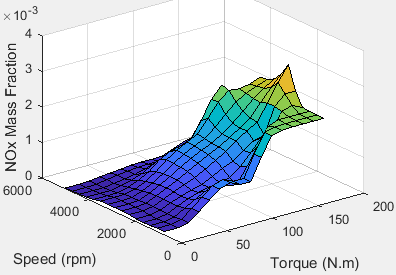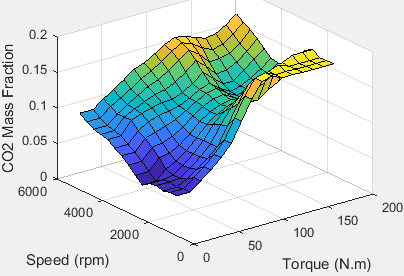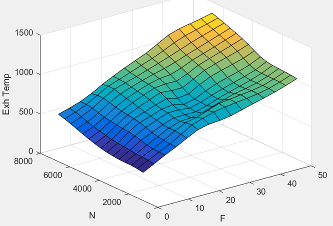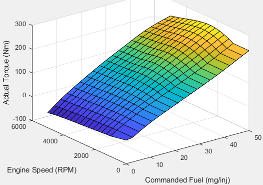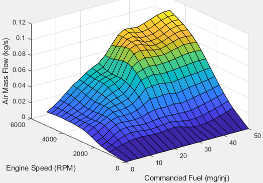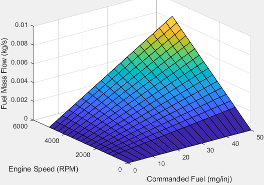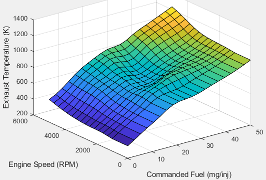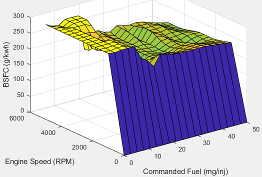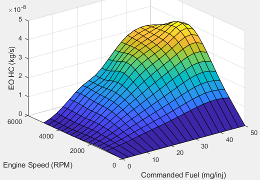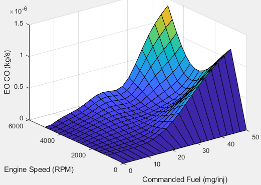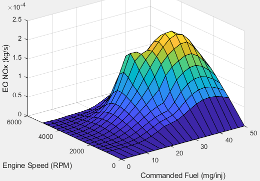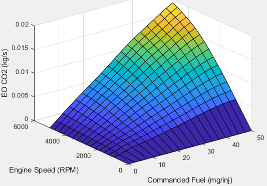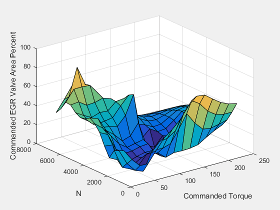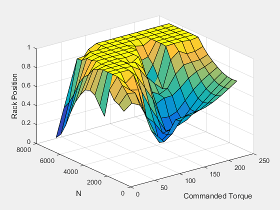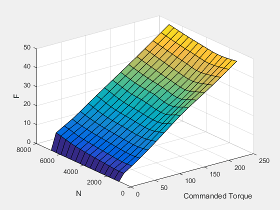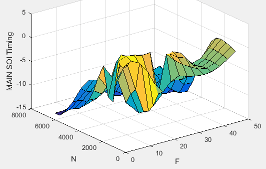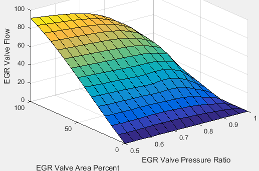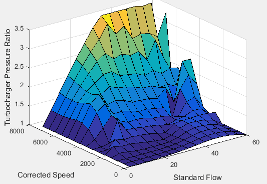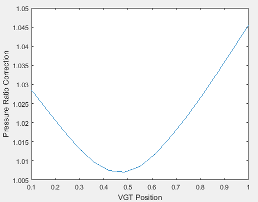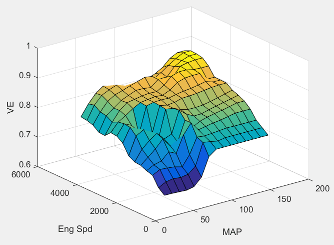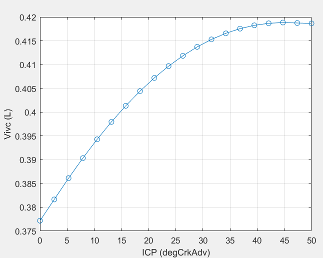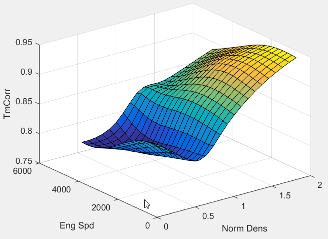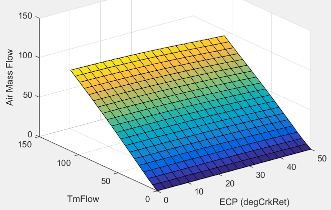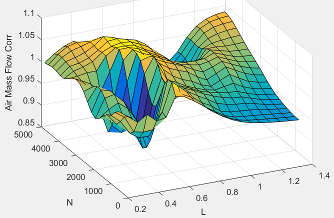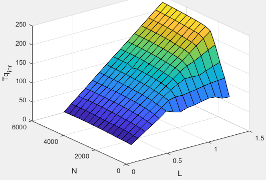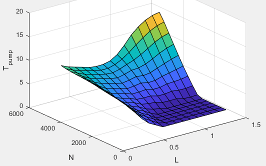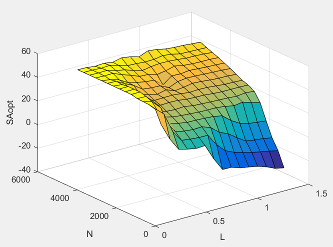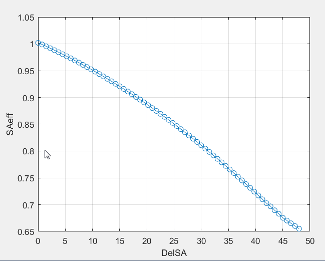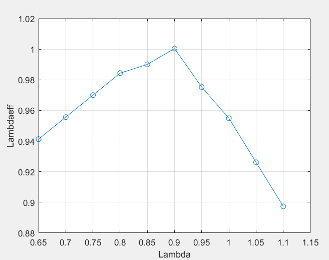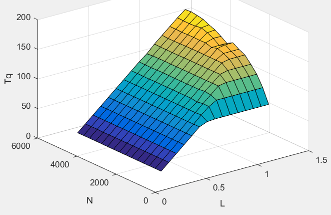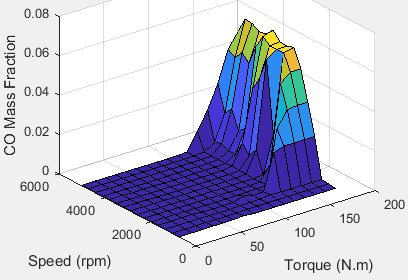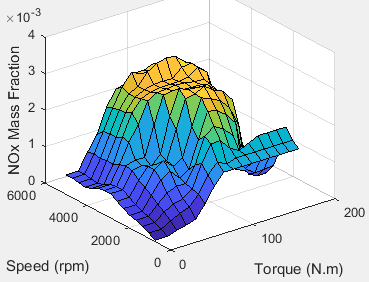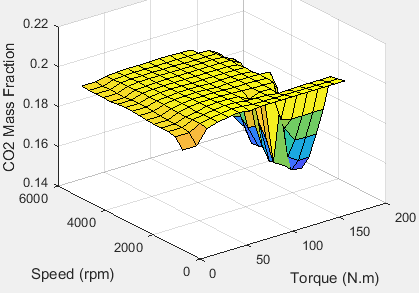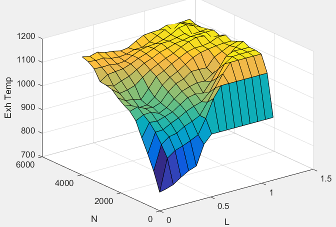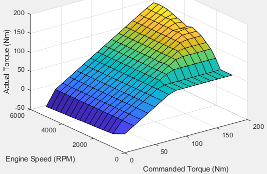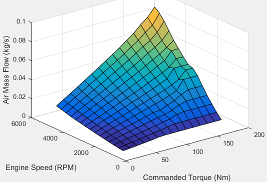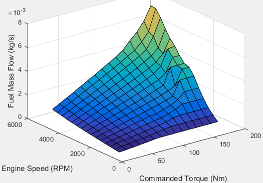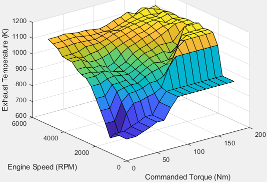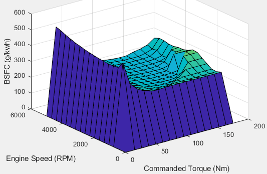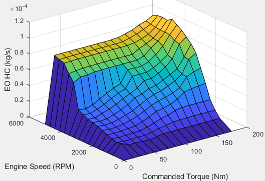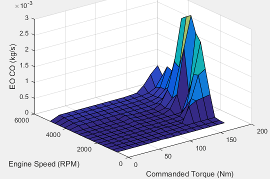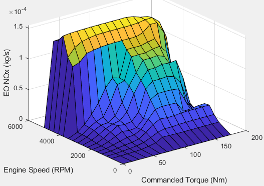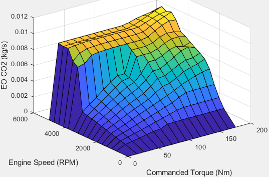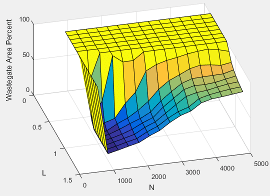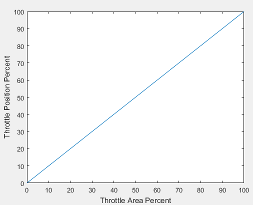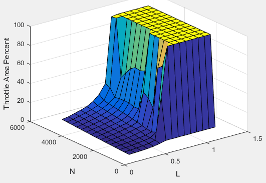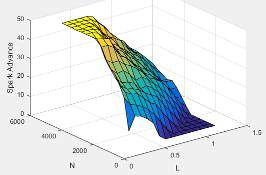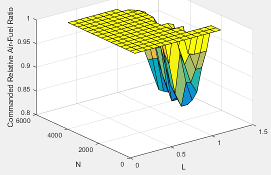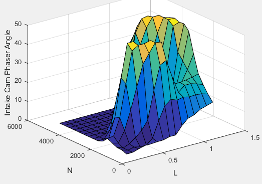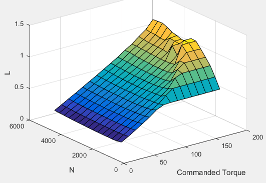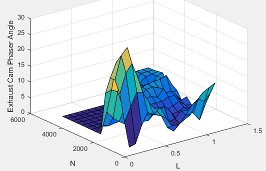Engine Calibration Maps
Calibration maps are a key part of the engine plant and controller models available in the Powertrain Blockset™. Engine models use the maps to represent engine behavior and to store optimal control parameters. Using calibration maps in control design leads to flexible, efficient control algorithms and estimators that are suitable for electronic control unit (ECU) implementation.
To develop the calibration maps for engine plant and controller models in the reference applications, MathWorks® developed and used processes to measure performance data from 1.5–L spark-ignition (SI) and compression-ignition (CI) engine models provided by Gamma Technologies LLC.
To represent the behavior of engine plants and controllers specific to your application, you can develop your own engine calibration maps. The data required for calibration typically comes from engine dynamometer tests or engine hardware design models.
Engine Plant Calibration Maps
The engine plant model calibration maps in the Powertrain Blockset SI and CI reference applications affect the engine response to control inputs (for example, spark timing, throttle position, and cam phasing).
To develop the calibration maps in the Powertrain Blockset engine plant models, MathWorks used GT-POWER models from the GT-SUITE modeling library in a Simulink®-based virtual dynamometer. MathWorks used the Model-Based Calibration Toolbox™ to create design-of-experiment (DoE) test plans. The Simulink-based virtual dynamometer executed the DoE test plan on GT-POWER 1.5–L SI and CI reference engines. MathWorks used the Model-Based Calibration Toolbox to develop the engine plant model calibration maps from the GT-POWER.
Engine Controller Calibration Maps
The engine controller model calibration maps in the reference applications represent the optimal open-loop control commands for given engine operating points.
To develop the calibration maps for the SI engine controller, MathWorks used the GT-POWER reference engine models in a virtual engine calibration optimization (VECO) process. The process optimized the open-loop control commands for 1.5–L SI engine, subject to engine operating constraints for knock, turbocharger speed, and exhaust temperature.
To develop the calibration maps for the CI engine controller, MathWorks used the DOE test data from the GT-POWER 1.5–L CI reference model operated at minimum brake-specific fuel consumption (BSFC).
Calibration Maps in Compression-Ignition (CI) Blocks
In the engine models, the Powertrain Blockset blocks implement these calibration maps.
| Map | Used For | In | Description |
|---|---|---|---|
Volumetric efficiency | The volumetric efficiency lookup table is a function of the intake manifold absolute pressure at intake valve closing (IVC) and engine speed where:
| ||
Optimal main start of injection (SOI) timing |
The optimal main start of injection (SOI) timing lookup table, ƒSOIc, is a function of the engine speed and injected fuel mass, SOIc = ƒSOIc(F,N), where:
| ||
Optimal intake manifold gas pressure |
The optimal intake manifold gas pressure lookup table, ƒMAP, is a function of the engine speed and injected fuel mass, MAP = ƒMAP(F,N), where:
| ||
Optimal exhaust manifold gas pressure |
The optimal exhaust manifold gas pressure lookup table, ƒEMAP, is a function of the engine speed and injected fuel mass, EMAP = ƒEMAP(F,N), where:
| ||
Optimal intake manifold gas temperature |
The optimal intake manifold gas temperature lookup table, ƒMAT, is a function of the engine speed and injected fuel mass, MAT = ƒMAT(F,N), where:
| ||
Optimal intake gas oxygen percent |
The optimal intake gas oxygen percent lookup table, ƒO2, is a function of the engine speed and injected fuel mass, O2PCT = ƒO2(F,N), where:
| ||
Optimal fuel rail pressure |
The optimal fuel rail pressure lookup table, ƒfuelp, is a function of the engine speed and injected fuel mass, FUELP = ƒfuelp(F,N), where:
| ||
Optimal gross indicated mean effective pressure |
The optimal gross indicated mean effective pressure lookup table, ƒimepg, is a function of the engine speed and injected fuel mass, IMEPG = ƒimepg(F,N), where:
| ||
Optimal friction mean effective pressure |
The optimal friction mean effective pressure lookup table, ƒfmep, is a function of the engine speed and injected fuel mass, FMEP = ƒfmep(F,N), where:
| ||
Optimal pumping mean effective pressure |
The optimal pumping mean effective pressure lookup table, ƒpmep, is a function of the engine speed and injected fuel mass, PMEP = ƒpmep(F,N), where:
| ||
Main SOI timing efficiency multiplier |
The main start of injection (SOI) timing efficiency multiplier lookup table, ƒSOIeff, is a function of the engine speed and main SOI timing relative to optimal timing, SOIeff = ƒSOIeff(ΔSOI,N), where:
| ||
Intake manifold gas pressure efficiency multiplier |
The intake manifold gas pressure efficiency multiplier lookup table, ƒMAPeff, is a function of the intake manifold gas pressure ratio relative to optimal pressure ratio and lambda, MAPeff = ƒMAPeff(MAPratio,λ), where:
| ||
Intake manifold gas temperature efficiency multiplier |
The intake manifold gas temperature efficiency multiplier lookup table, ƒMATeff, is a function of the engine speed and intake manifold gas temperature relative to optimal temperature, MATeff = ƒMATeff(ΔMAT,N), where:
| ||
Intake manifold gas oxygen efficiency multiplier |
The intake manifold gas oxygen efficiency multiplier lookup table, ƒO2Peff, is a function of the engine speed and intake manifold gas oxygen percent relative to optimal, O2Peff = ƒO2Peff(ΔO2P,N), where:
| ||
Indicated mean effective pressure post inject correction |
The indicated mean effective pressure post inject correction lookup table, ƒIMEPpost, is a function of the engine speed and fuel rail pressure relative to optimal breakpoints, ΔIMEPpost = ƒIMEPpost(ΔSOIpost,Fpost), where:
| ||
Fuel rail pressure efficiency multiplier |
The fuel rail pressure efficiency multiplier lookup table, ƒFUELPeff, is a function of the engine speed and fuel rail pressure relative to optimal breakpoints, FUELPeff = ƒFUELPeff(ΔFUELP,N), where:
| ||
Engine brake torque | For the simple torque lookup table model, the CI engine uses a lookup table is a function of engine speed and injected fuel mass, , where:
| ||
| Hydrocarbon (HC) mass fraction | HC emissions | The CI Core Engine HC emission mass fraction lookup table is a function of engine torque and engine speed, HC Mass Fraction = ƒ(Speed, Torque), where:
| |
| Carbon monoxide (CO) mass fraction | CO emissions | The CI Core Engine CO emission mass fraction lookup table is a function of engine torque and engine speed, CO Mass Fraction = ƒ(Speed, Torque), where:
| |
| Nitric oxide and nitrogen dioxide (NOx) mass fraction | NOx emissions | The CI Core Engine NOx emission mass fraction lookup table is a function of engine torque and engine speed, NOx Mass Fraction = ƒ(Speed, Torque), where:
| |
| Carbon dioxide (CO2) mass fraction | CO2 emissions | The CI Core Engine CO2 emission mass fraction lookup table is a function of engine torque and engine speed, CO2 Mass Fraction = ƒ(Speed, Torque), where:
| |
| Exhaust temperature | Engine exhaust temperature as a function of injected fuel mass and engine speed | The lookup table for the exhaust temperature is a function of injected fuel mass and engine speed where:
| |
| Engine brake torque | Engine brake torque as a function of commanded fuel mass and engine speed | Mapped CI Engine |
The engine brake torque lookup table is a function of commanded fuel mass and engine speed, = ƒ(F, N), where:
|
| Engine air mass flow | Engine air mass flow as a function of commanded fuel mass and engine speed | Mapped CI Engine |
The air mass flow lookup table is a function of commanded fuel mass and engine speed, = ƒ(Fmax, N), where:
|
| Engine fuel flow | Engine fuel flow as a function of commanded fuel mass and engine speed | Mapped CI Engine |
The engine fuel flow lookup table is a function of commanded fuel mass and engine speed, MassFlow= ƒ(F, N), where:
|
| Engine exhaust temperature | Engine exhaust temperature as a function of commanded fuel mass and engine speed | Mapped CI Engine |
The engine exhaust temperature table is a function of commanded fuel mass and engine speed, Texh= ƒ(F, N), where:
|
| Brake-specific fuel consumption (BSFC) efficiency | BSFC efficiency as a function of commanded fuel mass and engine speed | Mapped CI Engine |
The brake-specific fuel consumption (BSFC) efficiency is a function of commanded fuel mass and engine speed, BSFC= ƒ(F, N), where:
|
| Engine-out (EO) hydrocarbon emissions | EO hydrocarbon emissions as a function of commanded fuel mass and engine speed | Mapped CI Engine |
The engine-out hydrocarbon emissions are a function of commanded fuel mass and engine speed, EO HC= ƒ(F, N), where:
|
| Engine-out (EO) carbon monoxide emissions | EO carbon monoxide emissions as a function of commanded fuel mass and engine speed | Mapped CI Engine |
The engine-out carbon monoxide emissions are a function of commanded fuel mass and engine speed, EO CO= ƒ(F, N), where:
|
| Engine-out (EO) nitric oxide and nitrogen dioxide | EO nitric oxide and nitrogen dioxide emissions as a function of commanded fuel mass and engine speed | Mapped CI Engine |
The engine-out nitric oxide and nitrogen dioxide emissions are a function of commanded fuel mass and engine speed, EO NOx= ƒ(F, N), where:
|
| Engine-out (EO) carbon dioxide emissions | EO carbon dioxide emissions as a function of commanded fuel mass and engine speed | Mapped CI Engine |
The engine-out carbon dioxide emissions are a function of commanded fuel mass and engine speed, EO CO2= ƒ(F, N), where:
|
| Commanded exhaust gas recirculation (EGR) valve area percent | Commanded exhaust gas recirculation (EGR) valve area percent as a function of commanded torque and engine speed | CI Controller | The commanded exhaust gas recirculation (EGR) valve area percent lookup table is a function of commanded torque and engine speed where:
|
Variable geometry turbocharger (VGT) rack position | Variable geometry turbocharger (VGT) rack position as a function of commanded torque and engine speed | CI Controller | The variable geometry turbocharger (VGT) rack position lookup table is a function of commanded torque and engine speed where:
|
Commanded total fuel mass per injection | Commanded total fuel mass per injection as a function of torque command and engine speed | CI Controller | The commanded total fuel mass per injection table is a function of the torque command and engine speed where:
|
Main start-of-injection (SOI) timing | SOI timing as a function of commanded fuel mass and engine speed | CI Controller | The main start-of-injection (SOI) timing lookup table is a function of commanded fuel mass and engine speed where:
|
Standard exhaust gas recirculation (EGR) mass flow | EGR mass flow as a function of the standard flow pressure ratio and EGR valve flow area | CI Controller | The standard exhaust gas recirculation (EGR) mass flow is a lookup table that is a function of the standard flow pressure ratio and EGR valve flow area where:
|
Turbocharger pressure ratio | Turbocharger pressure ratio as a function of the standard air mass flow and corrected turbocharger speed | CI Controller | The turbocharger pressure ratio, corrected for variable geometry turbocharger (VGT) speed, is a lookup table that is a function of the standard air mass flow and corrected turbocharger speed, , where:
|
Turbocharger pressure ratio correction | Turbocharger pressure ratio correction as a function of the rack position | CI Controller | The variable geometry turbocharger pressure ratio correction is a function of the rack position, Prvgtcorr= ƒ(VGTpos), where:
|
Calibration Maps in Spark-Ignition (SI) Blocks
In the engine models, the Powertrain Blockset blocks implement these calibration maps.
| Map | Used for | In | Description |
|---|---|---|---|
Engine volumetric efficiency | The engine volumetric efficiency lookup table, , is a function of intake manifold absolute pressure and engine speed where:
| ||
Cylinder volume at intake valve close table (IVC) | The cylinder volume at intake valve close table (IVC), is a function of the intake cam phaser angle where:
| ||
Trapped mass correction | The trapped mass correction factor table, , is a function of the normalized density and engine speed where:
| ||
Air mass flow at cam phaser angles | The phaser intake mass flow model lookup table is a function of exhaust cam phaser angles and trapped air mass flow where:
| ||
Air mass flow correction | The intake air mass flow correction lookup table, , is a function of ideal load and engine speed where:
| ||
Inner torque | The inner torque lookup table, , is a function of engine speed and engine load, , where:
| ||
Friction torque | The friction torque lookup table, , is a function of engine speed and engine load, , where:
| ||
|
Pumping torque |
The pumping torque lookup
table, ƒTpump, is a function of engine load and engine
speed,
| ||
Optimal spark advance | The optimal spark lookup table, , is a function of engine speed and engine load, , where:
| ||
Spark efficiency | The spark efficiency lookup table, , is a function of the spark retard from optimal where:
| ||
Lambda efficiency | The lambda efficiency lookup table, , is a function of lambda, , where:
| ||
Simple torque | For the simple torque lookup table model, the SI engine uses a lookup table map that is a function of engine speed and load, , where:
| ||
Hydrocarbon (HC) mass fraction | HC emissions | The SI Core Engine HC emission mass fraction lookup table is a function of engine torque and engine speed, HC Mass Fraction = ƒ(Speed, Torque), where:
| |
Carbon monoxide (CO) mass fraction | CO emissions | The SI Core Engine CO emission mass fraction lookup table is a function of engine torque and engine speed, CO Mass Fraction = ƒ(Speed, Torque), where:
| |
Nitric oxide and nitrogen dioxide (NOx) mass fraction | NOx emissions | The SI Core Engine NOx emission mass fraction lookup table is a function of engine torque and engine speed, NOx Mass Fraction = ƒ(Speed, Torque), where:
| |
Carbon dioxide (CO2) mass fraction | CO2 emissions | The SI Core Engine CO2 emission mass fraction lookup table is a function of engine torque and engine speed, CO2 Mass Fraction = ƒ(Speed, Torque), where:
| |
Exhaust temperature | Engine exhaust calculation as a function of engine speed and load | The exhaust temperature lookup table, , is a function of engine load and engine speed where:
| |
| Engine torque | Engine brake torque as a function of commanded torque and engine speed | Mapped SI Engine |
The engine torque lookup table is a function of commanded engine torque and engine speed, T = ƒ(Tcmd, N), where:
|
| Engine air mass flow | Engine air mass flow as a function of commanded torque and engine speed | Mapped SI Engine |
The engine air mass flow lookup table is a function of commanded engine torque and engine speed, = ƒ(Tcmd, N), where:
|
| Engine fuel flow | Engine fuel flow as a function of commanded torque mass and engine speed | Mapped SI Engine |
The engine fuel mass flow lookup table is a function of commanded engine torque and engine speed, MassFlow = ƒ(Tcmd, N), where:
|
| Engine exhaust temperature | Engine exhaust temperature as a function of commanded torque and engine speed | Mapped SI Engine |
The engine exhaust temperature lookup table is a function of commanded engine torque and engine speed, Texh = ƒ(Tcmd, N), where:
|
| Brake-specific fuel consumption (BSFC) efficiency | Brake-specific fuel consumption (BSFC) as a function of commanded torque and engine speed | Mapped SI Engine |
The brake-specific fuel consumption (BSFC) efficiency is a function of commanded engine torque and engine speed, BSFC = ƒ(Tcmd, N), where:
|
| Engine-out (EO) hydrocarbon emissions | EO hydrocarbon emissions as a function of commanded torque and engine speed | Mapped SI Engine |
The engine-out hydrocarbon emissions are a function of commanded engine torque and engine speed, EO HC = ƒ(Tcmd, N), where:
|
| Engine-out (EO) carbon monoxide emissions | EO carbon monoxide emissions as a function of commanded torque and engine speed | Mapped SI Engine |
The engine-out carbon monoxide emissions are a function of commanded engine torque and engine speed, EO CO = ƒ(Tcmd, N), where:
|
| Engine-out (EO) nitric oxide and nitrogen dioxide emissions | EO nitric oxide and nitrogen dioxide emissions as a function of commanded torque and engine speed | Mapped SI Engine |
The engine-out nitric oxide and nitrogen dioxide emissions are a function of commanded engine torque and engine speed, EO NOx = ƒ(Tcmd, N), where:
|
| Engine-out (EO) carbon dioxide emissions | EO carbon dioxide emissions as a function of commanded torque and engine speed | Mapped SI Engine |
The engine-out carbon dioxide emissions are a function of commanded engine torque and engine speed, EO CO2 = ƒ(Tcmd, N), where:
|
Wastegate area percent command | Wastegate area percent command as a function of the commanded engine load and engine speed | SI Controller | The wastegate area percent command lookup table, , is a function of the commanded engine load and engine speed where:
|
Throttle position percent command | Throttle position percent command as a function of the throttle area percentage command | SI Controller | The throttle position percent command lookup table, , is a function of the throttle area percentage command where:
|
Throttle area percent command | Throttle area percent command as a function of commanded load and engine speed | SI Controller | The throttle area percent command lookup table, , is a function of commanded load and engine speed where:
|
Spark advance | Spark advance as a function of estimated load and engine speed | SI Controller | The spark advance lookup table is a function of estimated load and engine speed. where:
|
Commanded lambda | Commanded lambda as a function of estimated engine load and measured engine speed | SI Controller | The commanded lambda, , lookup table is a function of estimated engine load and measured engine speed where:
|
Intake cam phaser angle command | Intake cam phaser angle command as a function of the engine load and engine speed | SI Controller | The intake cam phaser angle command lookup table, , is a function of the engine load and engine speed where:
|
Commanded engine load | Commanded engine load as a function of the commanded torque and engine speed | SI Controller | The commanded engine load lookup table, , is a function of the commanded torque and engine speed where:
|
Exhaust cam phaser angle | Exhaust cam phaser angle as a function of the engine load and engine speed | SI Controller | The exhaust cam phaser angle command lookup table, , is a function of the engine load and engine speed where:
|
See Also
SI Core Engine | CI Core Engine | Mapped SI Engine | Mapped CI Engine | SI Controller | CI Controller
